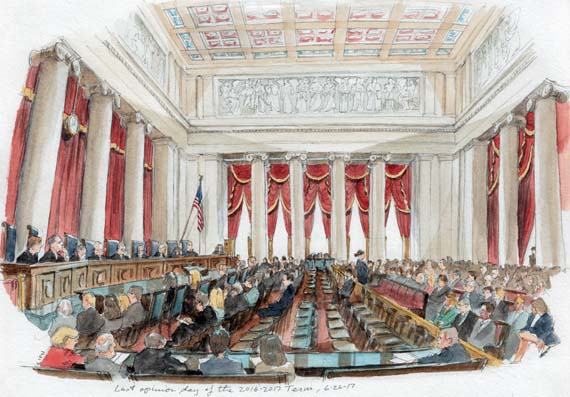Justice Gorsuch writing separately: Page length more than opinion numbers (so far)

on Jun 1, 2018 at 10:55 am

In a post at PrawfsBlawg, Dan Epps (who partners with this blog through the podcast he co-hosts, First Mondays) suggests that “Justice [Neil] Gorsuch’s apparent proclivity for writing separately seems likely to be part of the story” for why, as “of a couple weeks ago, the Court was setting records for the slow pace of opinions.” A similar suggestion comes from Joan Biskupic for CNN, who, writing in February and looking broadly at all of Gorsuch’s statements back to last term, suggested that Gorsuch’s “provocative writings may be spurring the other justices to take more time to respond.”
A quick look at Gorsuch’s separate opinions in argued cases this term offers a preliminary way to test this hypothesis. A little over halfway through the term’s decisions – 29 of 63 argued cases remain pending – it seems, at least so far, that Gorsuch does not in fact write separately more often than other justices. When he does write, however, he fills out more pages.
These are the rankings of the justices by number of authored concurrences and dissents. Gorsuch appears right in the middle of the justices.
Number of concurrences + dissents
Thomas: 10
Sotomayor: 7
Ginsburg: 6
Breyer/Alito/Gorsuch: 5
Roberts: 3
Kennedy: 1
Kagan: 0
Gorsuch does stand out for the length of his five separate opinions. These five opinions are, with page lengths in parentheses, his concurrences in Sessions v. Dimaya (19) and Jesner v. Arab Bank (14) and his dissents in Wilson v. Sellers (14), Artis v. District of Columbia (18) and Oil States Energy Services v. Greene’s Energy Group (12).
Average page length of concurrences + dissents
Gorsuch: 15.4
Roberts: 11.33
Sotomayor: 10.43
Breyer: 9.8 (not including his appendices in Patchak v. Zinke and Jennings v. Rodriguez)
Thomas: 9.4
Alito: 8.8
Ginsburg: 8.5
Kennedy: 2
Kagan: n/a
Gorsuch’s lengthy opinion writing is most pronounced for his concurrences. The average page length of his concurrences is over three times that of the next justice. The longest concurrences written by other justices – Justice Clarence Thomas’ concurrence in Jennings v. Rodriguez (13) and Justice Sonia Sotomayor’s concurrence in Ayestas v. Davis (11) – both come in under Gorsuch’s two concurrences.
In contrast, the average page length of Gorsuch’s dissents is at the low end of justices who have written a dissent this term.
Average page length of concurrences
Gorsuch: 16.5
Thomas: 5.14
Sotomayor: 4.8
Alito: 4
Breyer: 3.3 (including his opinion concurring in part and dissenting in part in Murphy v. NCAA)
Roberts: 3
Ginsburg: 2.5
Kennedy: 2
Breyer: 1.5 (not including NCAA)
Kagan: n/a
Average page length of dissents
Sotomayor: 24.5
Breyer: 21.5 (not including NCAA)
Thomas: 19.33
Roberts: 15.5
Breyer: 15.33 (including NCAA)
Gorsuch: 14.67
Alito: 12
Ginsburg: 11.5
Kennedy: n/a
Kagan: n/a
In his concurrences in Dimaya and Jesner, Gorsuch was not shy about laying out his vision of the law. Kevin Johnson writes for this blog that in Dimaya, in which the court ruled that the catchall section of the immigration law’s criminal-removal provision is unconstitutionally vague, Gorsuch “defended the originalist foundations for vagueness challenges” and “would have gone even further” than the plurality opinion, suggesting that “provisions of civil laws should be scrutinized closely for vagueness even outside the deportation context.”
Amy Howe writes for Howe on the Court, also published on this blog, that in Jesner, which held that foreign corporations cannot be sued for human-rights violations under the Alien Tort Statute, Gorsuch “would have gone even further than his colleagues and ruled that one foreign national cannot sue another under the ATS.”
Of the seven cases that have taken the justices the longest to decide this year, Gorsuch wrote in six of them — two majority opinions (Epic Systems Corp. v. Lewis and SAS Institute Inc. v. Lee), his two concurrences and two of his dissents (Wilson and Oil States). No other justice wrote in this many of the seven slowest decisions. Thomas wrote in five, Justice Stephen Breyer in four, Justice Ruth Bader Ginsburg in three, Justice Samuel Alito in two and the others in one apiece.
At least so far in the term, Gorsuch’s separate opinions in argued cases are not more frequent than those of his colleagues, but, at least with respect to his concurrences, they are appreciably longer. According to Epps, a long concurrence that dives deep into legal history may make more work for the rest of the justices than multiple short opinions, lending some support to the idea that Gorsuch’s separate writings slows down the court. Of course, 29 decisions over the next four weeks may alter this portrait. And, as Epps notes on PrawfsBlawg, we might need access to the justices’ papers for “a full explanation” of this term’s pace of opinions.


